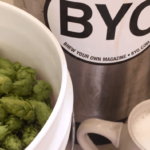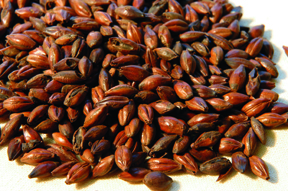Date: January-February 2009

Hook Norton Brewery’s Double Stout clone
The “double stout” in this beer’s name is not indicative of a strong beer. Actually, it’s quite low in gravity and makes a particularly good session pint. What the double means to me is that this beer literally has double the flavor of other low gravity stouts. East Kent Goldings hops lend a spicy character to the nose which blends in perfectly well with its rich, thick toasty body. The deep roast edges finish into a crisp dryness that ensures this beer’s utter drinkability. You better get this beer fast because it’s only seasonally available.
Avant Garde American Pale Ale
This beer won a gold medal in the first round of the 2008 NHC competition. Recipe written by Gordon Strong.
Classic American Pale Ale
Gordan Strong provides an all-grain version and extract with grains version of his first American Pale Ale recipe. It won gold medals in five different competitions.
Using spices
The Wiz remembers saying sayonara to a cinnamon beer.
Founders Brewing Co.’s Breakfast Stout clone
Founder’s describes this as “the coffee lover’s consummate beer.” Brewed with flaked oats, bitter and imported chocolate, and two types of coffee, this is indeed like the strong, dark cup of joe you’ll want for breakfast—or anytime!
Ferment in a Cornelius Keg
For those of you that keg your homebrew, chances are you’ve got at least one Cornelius keg sitting empty at any given time. Why not put them to good use as primary and/or secondary fermenters? And for those that don’t keg but are considering it in the future, picking up a keg or two for fermenting is a great way to start building up the equipment you’ll need for a kegerator. Used Cornelius kegs cost about $30 to $40, and with about $10 more in fittings and tubing you can have a 5-gallon (19-L) stainless steel fermenting vessel. The advantages of using a keg are that it’s light-tight, has built-in handles for easy transport and if you have a kegerator you can use your CO2 system to rack the beer in a completely closed environment with no siphoning.
Hop Polyphenols
What are hop polyphenols, and how do they affect bitterness in dry hopped beers?
Choosing Hop Varieties
There are many ingredients that brewers use to flavor and season their beer, from orange peel and coriander to black pepper and grains of paradise. But the gold standard remains the humble hop. Hops have long served many purposes in beer. They provide bitterness to balance the sweetness of malt, and add myriad flavors and aromas. When choosing which hop or combination of hops to include in a particular beer there are several questions that come to mind. What type and degree of bitterness, flavor and aroma is desired in the beer to be brewed? How are the bitterness, flavor and aroma derived from hops? What style of beer is being brewed, or am I leaving style guidelines behind to create something of my own?
Brewing American Pale Ale
What does it take to turn an average American pale ale into an awesome one? Guest columnist Gordon Strong explains the style.
Single malts
The Wiz has just one thing to say about single-malt Pilsner.
Fermenting Big Belgian-style Beers: Tips from the Pros
What’s the difference between fermenting everyday beers and fermenting the big, strong Belgians? The yeast of course. These three professional Belgian-style brewers talk about what it takes to keep your yeast happy, healthy and productive, even in the most extreme conditions.
Brown Malt
It has been known as blown, porter and snap malt, but homebrewers know it as brown malt, if they know it at all. Its mellow roast character, cheeky bitterness and acrid finish has warmed the cockles of many an Englishman over the centuries. It was once a malt of choice for many dark brews, especially porters and stouts. However, improvements in malting technology — including the development of pale base malts with better yields and dark specialty malts with more color — led to its decline. And it almost faded into brewing history. Almost. Today, a few maltsters — including Crisp, Thomas Fawcett and Sons, Hugh Baird and Beeston — produce brown malt and many homebrewers are discovering what made this lightly-roasted malt so popular in the past. Brown malt is back.







